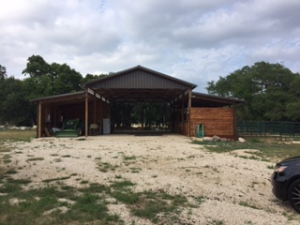I will confess….I have never ridden a horse. My daughter Bailey has more than averaged out the hours for me, as she has probably logged at least an entire year of 24 hour days in the saddle over the past decade.
I’ve been in countless riding arenas and have yet to see posted riding rules (unlike every swimming pool). Many riders break basic arena riding etiquette. I don’t think they do so to be disrespectful, but more because no one ever explained what is appropriate behavior in a public riding arena.
OK – I’m kind of off the “pole building” track here talking about horse riding etiquette. Today is Father’s Day as I write this and I’m thinking of my daughter with her horses and the riders she trains…at a horse show today. Sometimes I just have to …go with my brain flow!
Here are a few helpful hints…..
Don’t mount on the track; lead the horse to the center of the arena at a location away from other horses and to then mount. An option is to ride into the arena, provided the gate can be opened and closed while mounted.
Riders moving at the faster gait have priority on the track. If walking or riding slower, move to the inside. In most arenas, the faster person rides to the outside and the slower person moves inside to get out of the way.
 Communicate with other riders. For example, if making a circle, let other riders know to avoid accidental collisions. If about to start cantering and someone is on a green horse ahead, warn them or better yet, move away from an inexperienced horse and rider if transitioning to a faster gait. Most people are considerate and will move out of the way if they know.
Communicate with other riders. For example, if making a circle, let other riders know to avoid accidental collisions. If about to start cantering and someone is on a green horse ahead, warn them or better yet, move away from an inexperienced horse and rider if transitioning to a faster gait. Most people are considerate and will move out of the way if they know.
Don’t use loud verbal cues. Something sure to create haters in a crowded arena is to be constantly clucking and making kissy noises as horse cues. The same with rein slapping and yelling; both disturb other horses and could accidently cue a nearby horse and cause an accident. Loud cueing is considered rude. Learn to communicate in more subtle ways and save the voice commands for when training alone.
Leave dogs in the stands. Enough said.
If someone falls off – Stop. If another rider takes a tumble, don’t keep riding around. Stop your horse. If the closest rider, dismount and offer assistance. Help the person and catch their horse if it is loose. If the rider is injured appoint someone to call for help.
Think Left-left when passing from the opposite direction. At most arenas there is a rule to pass left shoulder to left shoulder if going in opposite directions. Most riders try to go in the direction of the other riders.
Practice safe distances. Just like driving a car, don’t get too close to the rear of other horses. The general rule is to keep at least a horse length distance between horses. For horses which kick, it is recommended to tie a red ribbon on the horse’s tail to provide a visual reminder to other riders.
Just like when driving, no talking or texting on cell phones while riding. If a call must absolutely be answered, move to the center of the ring, stop, and make it quick.
Keep gates closed while riding in an arena. This is a simple safety issue. If someone has an accident, the loose horse won’t run off if the gate is closed.
Use caution if lunging. First, ensure lunging is even allowed. Some arenas don’t allow lunging while riders are riding in the arena. Other stables allow it so long as the arena isn’t too crowded. If lunging try to do it in ways which least interfere with other riders. Use common sense and don’t have an attitude of lunging being a right. Treat being able to lunge as a gift.
Stay alert and practice courtesy. These are always good rules to live by, but they are especially important from a safety perspective in crowded arenas when factoring in the unpredictable nature of horses.
Tomorrow I’ll be back to buildings – I promise!






